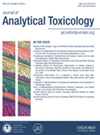Journal of Analytical Toxicology (JAT) is the international source for practical clinical/forensic applications for isolating, identifying and quantitating potentially toxic substances. The Journal of Analytical Toxicology (JAT) is an international publication devoted to the timely dissemination of scientific communications concerning the isolation, identification, and quantitation of drugs and other substances. Since its inception in 1977, JAT has striven to present state-of-the art techniques to address current issues in toxicology. The peer-review process provided by the distinguished members of the Editorial Advisory Board ensures the high quality and integrity of JAT articles. Timely presentation of the latest scientific developments is ensured through "Technical Notes", "Case Reports", and "Letters to the Editor". Worldwide readership of JAT includes toxicologists, pathologists, chemists, clinicians, researchers, and educators working in medical examiner and law enforcement laboratories, hospitals, university, and independent analytical laboratories, as well as the drug manufacturing industry. With an emphasis on practical application, JAT articles introduce improved and novel techniques for use in clinical, forensic, workplace, sports testing (doping), and other toxicology laboratories. Articles describe newly developed methods in immunoassay testing, gas chromatography, liquid chromatography, mass spectrometry, atomic absorption spectrometry, solid- and liquid-phase extraction techniques, and other analytical approaches. The methods published in JAT describe the chemical analysis of therapeutic drugs, drugs of abuse, pharmaceuticals, pesticides, industrial chemicals, and environmental toxins. The methods are generally applicable to the fields of forensic science, therapeutic drug monitoring, drug abuse testing, clinical and forensic toxicology, industrial hygiene.
